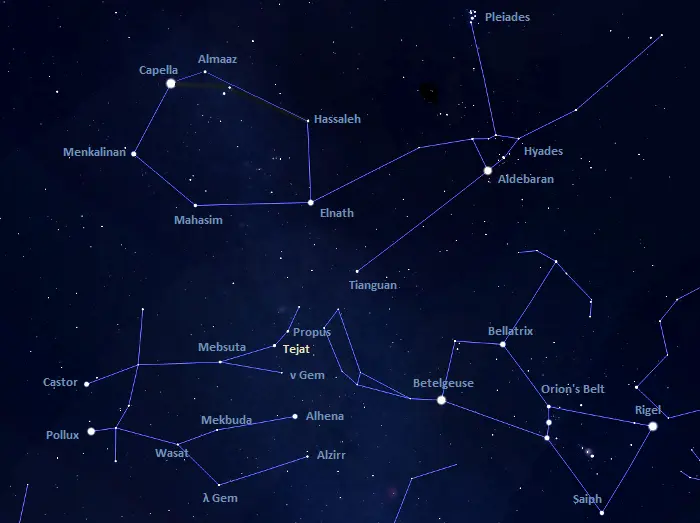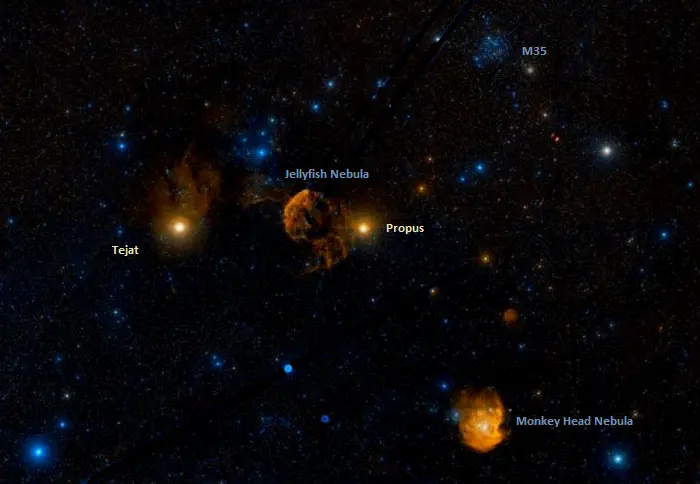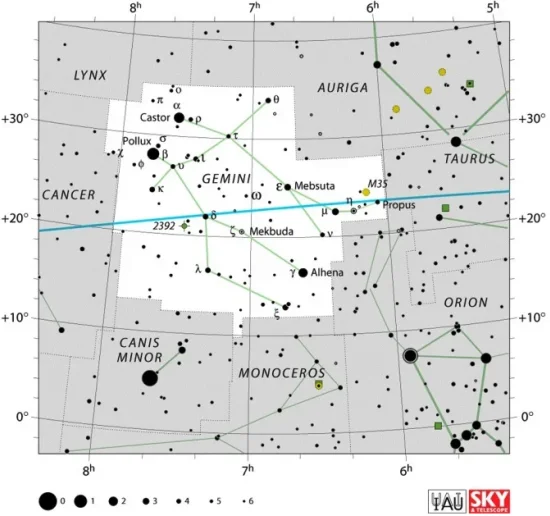Tejat, Mu Geminorum (μ Gem), is a red giant star located approximately 230 light-years away in the constellation Gemini. With an average apparent magnitude of about 2.9, it is the fourth brightest star in Gemini, after Pollux, Castor, and Alhena.
Star type
Tejat is a red giant of the spectral type M3 III. It has a mass of 2.1 solar masses and is 1,148 times more luminous than the Sun. Estimates of the star’s radius are between 80 and 104 solar radii.
Tejat has a surface temperature of 3,460 K and is cooler, yet brighter, than the Sun. The star would appear 0.07 magnitudes brighter if not for extinction from interstellar dust and gas, which absorb and scatter the star’s light.

Tejat (Mu Geminorum), image: Wikisky
Tejat is a star on the asymptotic giant branch. Its main source of energy is the nuclear fusion of hydrogen and helium in concentric shells around an inert carbon-oxygen core.
The star is classified as a slow irregular variable (type LB). It exhibits variations in brightness between magnitude 2.75 and 3.02 over a period of 72 days. It also shows long-term variations with a 2,000-day period.
Facts
Like Wasat and the nearby Propus, Tejat appears close to the ecliptic and can be occulted by the Moon and, less frequently, by planets. The star appears only 0.8 degrees south of the ecliptic.
In Arabic astronomy, Tejat, Propus (Eta Geminorum), Alhena (Gamma Geminorum), Alzirr (Xi Geminorum), and Nu Geminorum formed an asterism called Al Han’ah, meaning “the brand.” The asterism represented the brand on a camel’s neck. The name Alhena is derived from the name of the asterism.
Name
The name Tejat (pronunciation: /ˈtiːdʒət/) comes from the Arabic tiḥyāt, a word of unknown meaning. Mu Geminorum was traditionally known as Tejat Posterior. The name once applied to an asterism that the star formed with Alhena (Gamma Geminorum), Propus (Eta Geminorum), Nu Geminorum, and Alzirr (Xi Geminorum). Propus (Eta Geminorum) was known as Tejat Prior.
The name Tejat was approved for Mu Geminorum by the International Astronomical Union’s (IAU) Working Group on Star Names (WGSN) on February 1, 2017.
Mu Geminorum was historically also called Calx (the Latin word for “heel”), Nuhatai (the dual form of the Arabic ‘Al Nuḥāt’, meaning “a camel’s hump”), Dirah (from Al Dirah, meaning “the seed” or “the branch”), and Pish Pai (from the Persian word for “foreleg”).
In Chinese astronomy, Tejat was called 井宿一 (Jǐng Su yī), the First Star of Well. The Well asterism was formed by Mu Geminorum with Alhena (Gamma Geminorum), Nu Geminorum, Alzirr (Xi Geminorum), Mebsuta (Epsilon Geminorum), 36 Geminorum), Mekbuda (Zeta Geminorum), and Lambda Geminorum. The asterism was part of the Well mansion, one of the southern mansions of the Vermilion Bird.
Location
Tejat lies about 22 degrees north of the celestial equator. It is easy to find because it appears in an area full of bright stars. It is the brightest of the three stars at the feet of Castor, the western twin of Gemini.
The star appears along the imaginary line extended from Alnitak, the leftmost star of Orion’s Belt, through Betelgeuse. Alternatively, it can be found by following the line of the Bull’s southern horn from Aldebaran (Alpha Tauri) through Tianguan (Zeta Tauri).

The location of Tejat in the night sky, image: Stellarium
Tejat and its neighbour Propus can be used to find the Jellyfish Nebula (IC 443), the bright star cluster Messier 35, and the Monkey Head Nebula (NGC 2174). The Jellyfish Nebula is a supernova remnant located approximately 5,000 light years away. It appears between the two stars, closer to Propus.
Messier 35 is an open cluster 2,970 light-years away. With an apparent magnitude of 5.3 and an apparent size of 28 arcminutes, it is easily observed in binoculars and small telescopes. The Monkey Head Nebula is an emission nebula in the northern part of Orion, the Hunter. It lies about 6,400 light-years away.

Tejat, Propus, the Jellyfish Nebula, the Monkey Head Nebula, and Messier 35, image: Wikisky
Constellation
Tejat is located in the constellation of Gemini. Gemini is one of the ancient constellations catalogued by Claudius Ptolemy of Alexandria in his Almagest in the 2nd century CE. In Greek mythology, the constellation is associated with the twins Pollux and Castor. The heads of the twins are marked by the stars Pollux and Castor (Beta and Alpha Geminorum), the 17th and 23rd brightest stars in the sky.
Other notable stars in the constellation include the spectroscopic binary system Gamma Geminorum (Alhena), the supergiants Mebsuta and Mekbuda, and the dwarf nova U Geminorum.

Gemini constellation map by IAU and Sky&Telescope magazine
The best-known deep sky objects in Gemini are the supernova remnant IC 443 (the Jellyfish Nebula), the planetary nebulae Sh2-274 (the Medusa Nebula) and NGC 2392, and the open clusters Messier 35 and NGC 2129.
The best time of the year to observe the stars and deep sky objects of Gemini is during the month of February, when the constellation is high above the horizon in the evening sky. The entire constellation is visible from locations north of the latitude 60° S.
The 10 brightest stars in Gemini are Pollux (Beta Gem, mag. 1.14), Castor A (Alpha Gem A, mag. 1.93), Alhena (Gamma Gem, mag. 1.9), Tejat (Mu Gem, mag. 2.86), Castor B (Alpha Gem B, mag. 2.97), Mebsuta (Epsilon Gem, mag. 3.06), Propus (Eta Gem A, mag. 3.15 – 3.90), Alzirr (Xi Gem, mag. 3.35), Wasat (Delta Gem, mag 3.53), and Kappa Geminorum (mag. 3.568).
Tejat – Mu Geminorum
| Spectral class | M3 III |
| Variable type | Irregular (LB) |
| U-B colour index | +1.924 |
| B-V colour index | +1.643 |
| Apparent magnitude | 2.75 – 3.02 |
| Absolute magnitude | -1.42 |
| Distance | 230 ± 10 light-years (71 ± 4 parsecs) |
| Parallax | 14.08 ± 0.71 mas |
| Radial velocity | +54.38 ± 0.24 km/s |
| Proper motion | RA: +56.39 ± 0.85 mas/yr |
| Dec.: –110.03 ± 0.51 mas/yr | |
| Mass | 2.1 M☉ |
| Luminosity | 1,148 L☉ |
| Radius | 80 R☉ or 104 ± 8 R☉ |
| Temperature | 3,460 K |
| Metallicity | -0.03 dex |
| Rotational velocity | 8.4 km/s |
| Surface gravity | 0.82 cgs |
| Constellation | Gemini |
| Right ascension | 06h 22m 57.6896474549s |
| Declination | +22° 30′ 47.155377629″ |
| Names and designations | Tejat, Mu Geminorum, μ Gem, 13 Geminorum, HD 44478, HR 2286, HIP 30343, BD+22°1304, SAO 78297, PPM 95868, FK5 241, AG+22 693, PLX 1475.00, CSV 740, DO 12155, GC 8208, GCRV 4046, JP11 1371, IRAS 06199+2232, 2MASS J06225762+2230490, UBV 6376, TYC 1878-1429-1, Gaia DR3 3377166289889430656, ADS 4990A, IDS 06169+2234 A, CCDM J06230+2230A, WDS J06230+2231A |